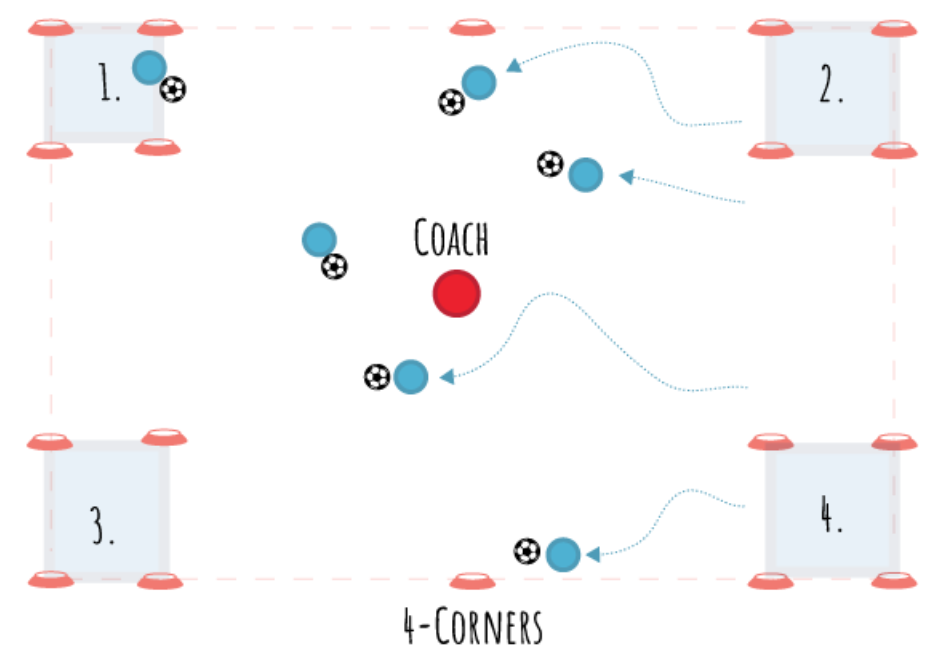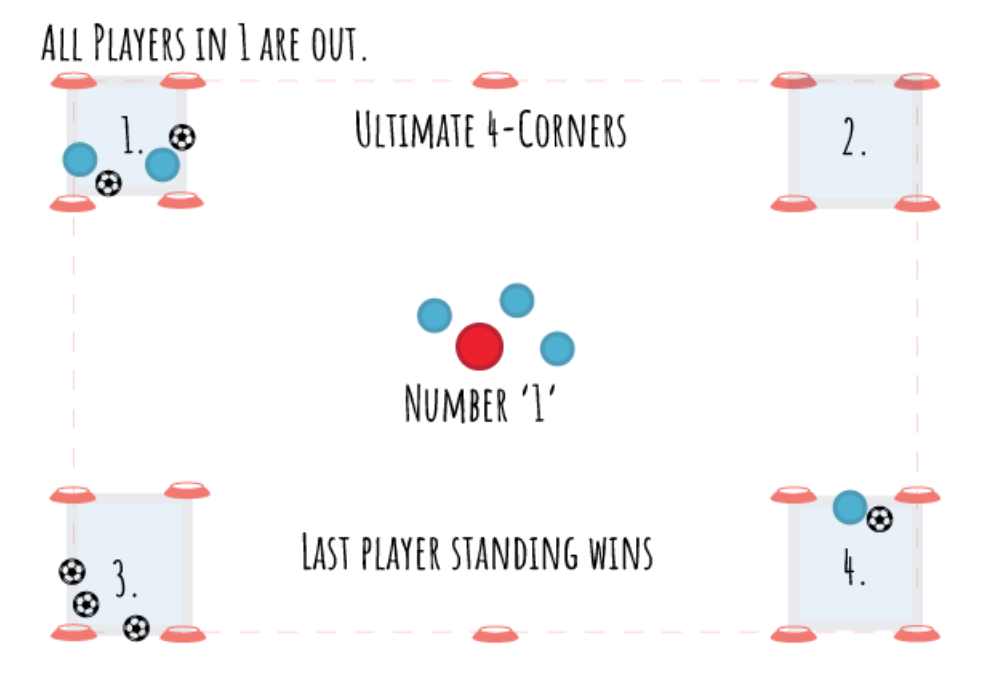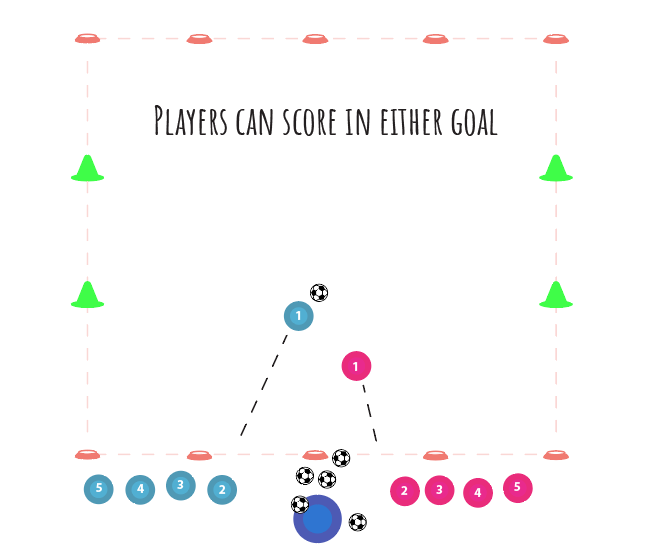Session 5.
Warm-Up
Free Play with Focus (2 minutes)
All players: Grab a ball and spend the next two minutes practicing whatever soccer skills you want to improve.
Age-Specific Suggestions:
Younger players: Try different ways to change direction while keeping the ball close to you. Can you stop quickly, turn, or dribble around cones?
Older players: Challenge yourself with juggling or advanced dribbling moves. How many juggles can you do in a row? Can you master a new dribbling trick?
Key Points:
The main goal is to let players have some fun and explore their skills.
The age-specific suggestions offer guidance but aren't mandatory.
If time allows, briefly demonstrate a few dribbling moves or juggling techniques before they start.
Game #1.
Four Corners - 15/20 minutes
Set Up
Create a large square playing area with cones marking each of the four corners.
Decide whether players will have a ball or not.
How to Play
Run to a Corner: Players freely run to any of the four corners.
Countdown: The coach (or a designated student) stands in the middle, closes their eyes, and counts down from 10.
Call a Corner: At the end of the countdown, they shout out a number from 1 to 4.
Perform a Task: Players in the called corner must perform a skill, exercise, or fun activity (like a Fortnite dance!).
Introduce New Condition
Time Limit:
Race to the Corners: Set a time limit (e.g., 20 seconds). Players must dribble their ball (if using one) to a corner within that time.
Coach as Obstacle: The coach tries to gently impede players from reaching a corner.
Frozen Players: Players who don't make it to a corner in time are frozen. They can only be unfrozen if another player tags them.
Ultimate Four Corners (Elimination):
Elimination: When a corner number is called, anyone in that corner is out of the game.
Last One Standing: The goal is for the person in the middle to eliminate everyone within a time limit, OR the last player remaining wins.
Four Corners Switch-Up:
Corner Assignments: Instead of players choosing corners, assign each player a specific corner at the start of the game.
Countdown and Corner Switch: The coach or student in the middle counts down from 10. Instead of calling out a single corner number, they will call out two corner numbers.
Quick Switch: Players in the two called corners must quickly switch places before the counter in the middle reaches zero.
Caught in the Middle: Any player who doesn't make it to their new corner in time is out.
Last One Standing: The game continues until only one player is left.
Additional Tips & Variations:
Vary the Switch: Instead of calling out two corners, the counter could call out "Switch!" and all players must move to a different corner.
Team Version: Divide players into teams and assign each team two corners. When two corners are called, the teams must switch places. The first team with all members in their new corners earns a point.
Provide clear demonstrations of each skill before the game starts.
Offer positive feedback and encouragement throughout the activity.
Adjust the skills and time limits based on the age and skill level of the players.
This variation adds an element of surprise and quick decision-making, challenging players' agility and reaction times.
Game #2.
Sonic The Hedgehog - 15/20 minutes
Set-up
Each student tucks a pinnie or bib into the back of their pants like a tail – they are now "Tails," Sonic's sidekick.
Choose a few students (or yourself) to be "Sonic the Hedgehog."
How to Play
Chase and Grab: Sonic chases the Tails, trying to pull their tails out.
Role Reversal: If Sonic successfully grabs a tail, the roles switch. The student who lost their tail becomes Sonic and chases the others, while the original Sonic becomes a Tails.
Time Limit: Play for a set time. Each student earns 1 point for every second they keep their tail.
Introduce New Conditions
Progression 1: Rock, Paper, Scissors
When a student grabs a tail, they play Rock, Paper, Scissors with the person they tagged.
The winner of the RPS match takes the tail and becomes a Tails.
Remember to keep the instructions clear, concise, and encouraging!
Progression 2: High Stakes
Each student tries to collect as many tails as possible.
When a tail is grabbed, the two students play Rock, Paper, Scissors.
The winner takes all the tails the loser was holding.
This means a student with multiple tails can lose them all in one RPS match!
Progression 3: Tails Rescue Mission
Designate a specific area as the "Jail" or "Capture Zone."
When Sonic grabs a tail, the captured Tails must go to the Jail.
Other Tails can try to "rescue" their captured teammates by tagging them in the Jail.
If a Tails successfully tags a captured teammate, they both return to the game.
Sonic can also try to tag rescuing Tails in the Jail to capture them as well.
Progression 4: Team Tails
Divide the students into two or more teams.
Each team has a designated "home base" area.
Players try to grab tails from opposing teams and bring them back to their home base.
The team with the most tails at the end of the game wins.
Additional Tips & Variations:
You can add obstacles or safe zones to the playing area to make the game more dynamic.
Consider incorporating music or sound effects to enhance the atmosphere and excitement.
Encourage creativity and let the students come up with their own variations or challenges within the game.
Scrimmages
Set Up
Divide the players into two groups and organize a 5v5 game on each field.
Use the bibs to clearly distinguish the teams.
Your Role
Facilitate Understanding: Make sure the players understand the basic rules of the game. Clarify any questions they have and ensure everyone is on the same page.
Skill Integration: At the beginning of each game, remind the players of the specific skill they practiced during the warm-up and the fun games. Encourage them to actively try and use that skill during the game. Example: If the games focused on dribbling, you might say something like, "Remember those dribbling moves we just practiced? Let's see you use them to get past defenders and create scoring chances!"
Additional Tips
Observe and Provide Feedback: Watch the games closely and offer positive feedback and constructive suggestions to individual players and teams.
Keep it Fun: Maintain a positive and encouraging atmosphere. The main goal is for the kids to enjoy playing and learning.
Be Flexible: Adjust the game format or rules if necessary to ensure everyone is engaged and having a good time.
Remember, your enthusiasm and guidance will go a long way in helping the players develop their skills and love for the game!
End Chat
Bring the group in at the end of the session and ask questions about the what they just worked on. Examples:
Q. What did you do in the session?
Q. What did you learn?
Give stickers out to kids who did well.
Choose a child who did a great job and they choose the end cheer for the group.









